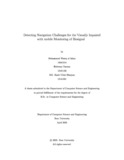Detecting navigation challenges for the visually impaired with mobile monitoring of biosignal
Abstract
In recent years, mobile Brain Computer Interface (BCI) has gained much popularity in the design of navigation aids. This opens up the platform to build navigation aids based on the level of stress imposed on visually impaired people (VIPs). The goal is to build a bridge between different environments and the cognitive load on VIP navigating through those environments. In order to do that, the first step is to label the cognitive load each possible type of environment imposes on the VIPs. For the purposes of this study the stimuli have been narrowed down to indoor environments. Cognitive psychology defines cognitive load as the used amount of working memory resources. Working memory performance is measured by the spectral changes in the alpha frequency band in an Electroencephalography (EEG) report. This correlation provides a measurable quantity to determine the overall cognitive load associated with a task. Besides alpha bands, beta activity has also been linked to psychological and physiological stress, which in effect is imposed on cognition. The oscillations in another frequency band, gamma have also been observed to increase with memory load. Putting the above together, the bio signals in the alpha, beta and gamma frequency ranges are useful for detecting the cognitive load of the subject. The data set used in this study has been obtained from the European Union from one of their experiments for VIP. It constitutes of EEG signals taken from 9 visually impaired people as they navigated through various indoor environments. Features are extracted using Welch's Power Spectral Density (WPSD) from the relevant bands of the EEG signals. A Machine Learning algorithm is used for classification. The features are mapped onto different cognitive levels as labels and a Support Vector Machine (SVM) trained to classify the stress levels of the VIPs. The AUROC is around 90% for each environment analysed in this research.

